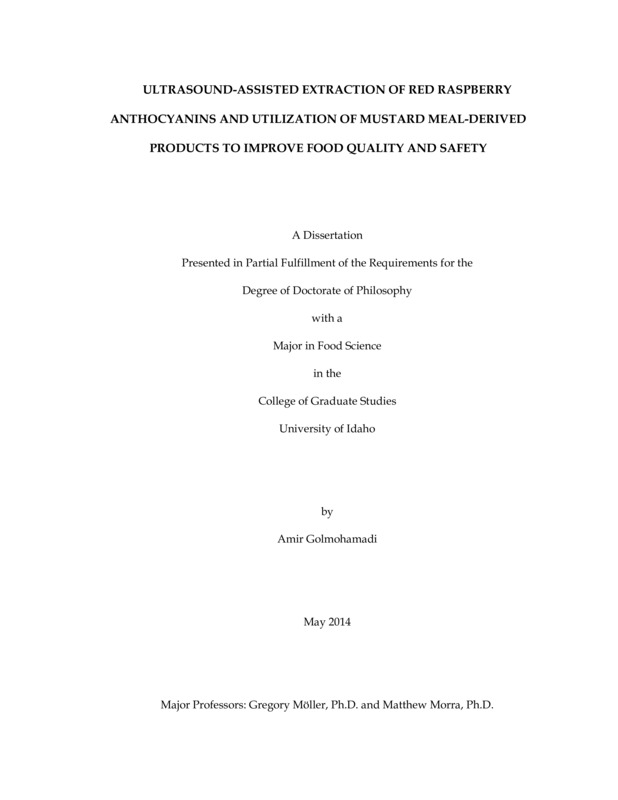ULTRASOUND-ASSISTED EXTRACTION OF RED RASPBERRY ANTHOCYANINS AND UTILIZATION OF MUSTARD MEAL-DERIVED PRODUCTS TO IMPROVE FOOD QUALITY AND SAFETY
GOLMOHAMADI, AMIR. (2014). ULTRASOUND-ASSISTED EXTRACTION OF RED RASPBERRY ANTHOCYANINS AND UTILIZATION OF MUSTARD MEAL-DERIVED PRODUCTS TO IMPROVE FOOD QUALITY AND SAFETY. Theses and Dissertations Collection, University of Idaho Library Digital Collections. https://www.lib.uidaho.edu/digital/etd/items/golmohamadi_idaho_0089e_10150.html
- Title:
- ULTRASOUND-ASSISTED EXTRACTION OF RED RASPBERRY ANTHOCYANINS AND UTILIZATION OF MUSTARD MEAL-DERIVED PRODUCTS TO IMPROVE FOOD QUALITY AND SAFETY
- Author:
- GOLMOHAMADI, AMIR
- Date:
- 2014
- Keywords:
- Anthocyanins lactoperoxidase system mustard meal Red raspberry Sinapis alba Ultrasound Extraction
- Program:
- Food Science
- Subject Category:
- Food science
- Abstract:
-
Power ultrasound (20-1000 kHz) potentially can improve the extraction of bioactive compounds. The objectives of this research were to study the effect of three frequencies of ultrasound (20, 490, and 986 kHz) on antioxidant activity (AOA), total phenolic content (TPC), and anthocyanin content (ACY) of red raspberry puree (RP), to extract thiocyanate (SCN-) from mustard seed meal (Sinapis alba), and finally to generate and optimize hypothiocyanite (OSCN-) production from mustard meal (MM) SCN- in the lactoperoxidase system (LPSys). The RP was subjected to the three ultrasound frequencies for 10-30 minutes and aqueous solutions of MM were sonicated for 5-30 minutes at 20 kHz. The MM-SCN- (or KSCN as control) was then mixed with lactoperoxidase enzyme (LPD) and exogenous H2O2 in a buffered solution (pH 6). Sustained production of H2O2 was achieved by using glucose and glucose oxidase (GOD). In the case of red raspberry puree, sonication at 20 and 490 kHz significantly (P<0.05) affected the AOA, ACY, and TPC of RP, while 986 kHz only increased TPC after 30 minutes (P<0.05). Sonication at 20 kHz for 10 minutes caused an increase (P<0.05) of AOA and ACY by 17.3 % and 12.6%. It was demonstrated that when limited to 10 minutes, 20 kHz was the most effective treatment for extraction of bioactive compounds in RP compared to 490 and 986 kHz. Therefore, 20 kHz was used to study the generation of SCN- from mustard meal. Five and 30 minutes of sonication generated SCN- concentrations that were equal to 24 h and 3 days of conventional extraction, respectively (P<0.05). Both of these protocols produced results that could also be achieved with 10 minutes of extraction at 70˚C. When exogenous H2O2 was used to activate the LPSYS, MM-SCN generated the same concentration of OSCN- as the KSCN-LPSys. The optimized LPSys at fixed LPD (3.92 IU/ml) contained 500 µM SCN-, 32-64 mM glucose, and 342 IU/l GOD. This investigation has shown that an increase in ultrasound power by itself cannot improve the- extraction. Mustard meal SCN- would qualify as a generally recognized as safe material with potential applications in the food industry to inhibit the growth of food borne pathogens.
- Description:
- doctoral, Ph.D., Food Science -- University of Idaho - College of Graduate Studies, 2014
- Major Professor:
- Moller, Gregory; Morra, Matthew J
- Committee:
- Rasco, Barbara; Powers, Joseph; Nindo, Caleb
- Defense Date:
- 2014
- Identifier:
- GOLMOHAMADI_idaho_0089E_10150
- Type:
- Text
- Format Original:
- Format:
- application/pdf
- Rights:
- In Copyright - Educational Use Permitted. For more information, please contact University of Idaho Library Special Collections and Archives Department at libspec@uidaho.edu.
- Standardized Rights:
- http://rightsstatements.org/vocab/InC-EDU/1.0/

